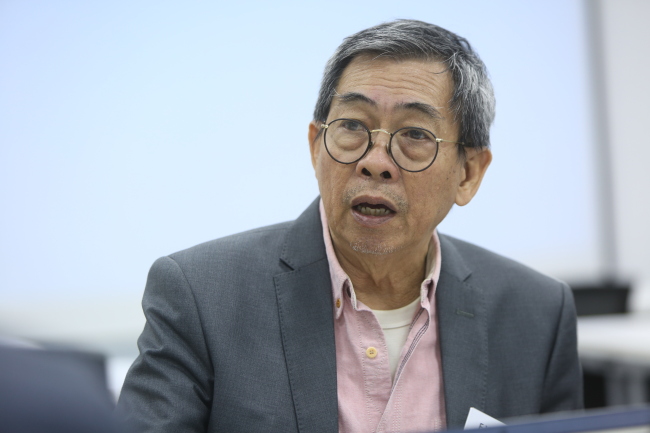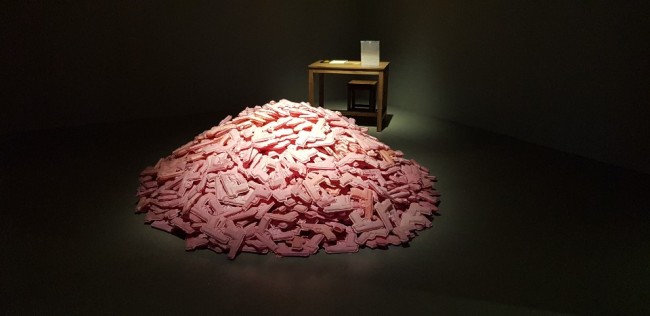Indonesian artist asks ‘What Would You Do if These Crackers Were Real Pistols?’
FX Harsono participates in MMCA show tracing changes in Asia from ’60s to ’90s
By Shim Woo-hyunPublished : Feb. 10, 2019 - 16:33
Asked “What Would You Do if These Crackers Were Real Pistols?” Indonesian artist FX Harsono replied, “I wanted to shoot my teacher. He was the director of my art school and kicked me out from the school. He was financially corrupted and also part of many scandals associated with women.”
The question forms the title of the artist’s 1977 work on display at the National Museum of Modern and Contemporary Art’s Gwacheon branch as part of the exhibition “Awakenings: Art in Society in Asia 1960s-1990s.” The work was a political statement against former Indonesian President Suharto’s military junta, consisting of a pile of handmade pistol crackers and a desk with a stack of answer sheets to the question.
The question forms the title of the artist’s 1977 work on display at the National Museum of Modern and Contemporary Art’s Gwacheon branch as part of the exhibition “Awakenings: Art in Society in Asia 1960s-1990s.” The work was a political statement against former Indonesian President Suharto’s military junta, consisting of a pile of handmade pistol crackers and a desk with a stack of answer sheets to the question.

“At that time, I saw a person who was carrying a pistol cracker on the back of his bicycle. I told him that I wanted to buy those pistol crackers. That was in 1977. I bought the pistol crackers and just poured them on a gallery floor. A lot of people then linked my work with militarism, the regime,” Harsono recalled during an interview at the MMCA Gwacheon on Jan. 30.
In the early years of his career, Harsono -- credited with leading the contemporary art scene in Indonesia -- devoted himself to creating artworks and performances in response to social and political issues in Indonesia. He does not espouse “art for art’s sake”
“When I was a high school senior, I was already participating in organizations in school and everywhere. I was interested in organizations involved with politics. At that time I realized that I did not agree with the political situation in Indonesia -- mostly about the strong military regime that brought suppression upon the people,” Harsono said.
“My art has to make good for other people and be something that can make changes,” the artist went on to say, adding that he believes the accumulation of people’s efforts can bring about changes.
“During Suharto’s regime, there was no freedom of speech, but fortunately the, military regime was ignorant of visual arts that use symbols and metaphors. The regime could not quite understand what visual arts are. Because most of the visual artworks were shown in gallery space, but not in a public space, the regime regarded visual arts (as something that) could not make any social movement.”

Harsano’s artworks shed light on the historical and social context of that period in Indonesia. Suharto was a military leader and president of the Southeast Asian nation for more than three decades.
Bringing works of site-specific historical context to an international show like the MMCA’s is meaningful because it allows artworks to be viewed in a much broader scope, Harsono says.
“I did not know anything about the relationship between Indonesia and other Asian countries. From this exhibition, I have realized that a lot of things changed between the 1960s and the 1990s. Now I feel that our movement has certain ties with other political and cultural situations in other Asian countries.”
Exhibitions bringing Asian artists together are also a powerful means to counter the global art scene dominated by the West, according to Harsono.
“If Western curators or institutions want to see Southeast Asian arts, they always use their own criteria. They want to see Indonesia from their side,” he said, pointing out that Indonesia is frequently viewed just as an exotic country.
“They still have a mindset that artists from Southeast Asia are not important in the contemporary art scene,” he added.
“I think it is important to show the world that we have good works. Maybe the forms look the same, but the context is totally different. This is the time, I think, (to) show to the world Asia also has power in culture.”
Many things have changed in Indonesia since 1998 with the collapse of the Suharto regime, the artist observed. For instance, there is more freedom of speech, and people can now criticize the government more openly.
“People’s interests have also changed,” he said.
“I would shoot the guy who cheated with my girlfriend” was among recent answers to his work “What Would You Do if These Crackers Were Real Pistols?” according to the artist.
Such responses are an indication that times have changed -- and so have Harsono’s interests. “I started to talk about myself, my identity as a Chinese-Indonesian -- an identity that has long been discriminated against,” he said.
“Now I will use pistols to protect myself from personal threats.”
By Shim Woo-hyun (ws@heraldcorp.com)









![[Today’s K-pop] BTS pop-up event to come to Seoul](http://res.heraldm.com/phpwas/restmb_idxmake.php?idx=644&simg=/content/image/2024/04/17/20240417050734_0.jpg&u=)
![[Graphic News] More Koreans say they plan long-distance trips this year](http://res.heraldm.com/phpwas/restmb_idxmake.php?idx=644&simg=/content/image/2024/04/17/20240417050828_0.gif&u=)
![[KH Explains] Hyundai's full hybrid edge to pay off amid slow transition to pure EVs](http://res.heraldm.com/phpwas/restmb_idxmake.php?idx=644&simg=/content/image/2024/04/18/20240418050645_0.jpg&u=20240419100350)





![[KH Explains] Hyundai's full hybrid edge to pay off amid slow transition to pure EVs](http://res.heraldm.com/phpwas/restmb_idxmake.php?idx=652&simg=/content/image/2024/04/18/20240418050645_0.jpg&u=20240419100350)

